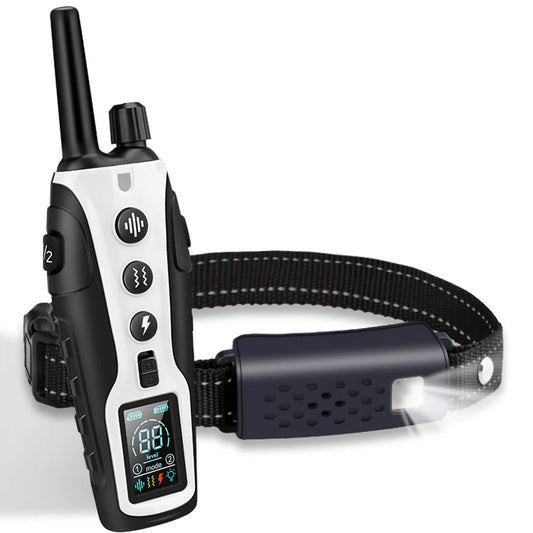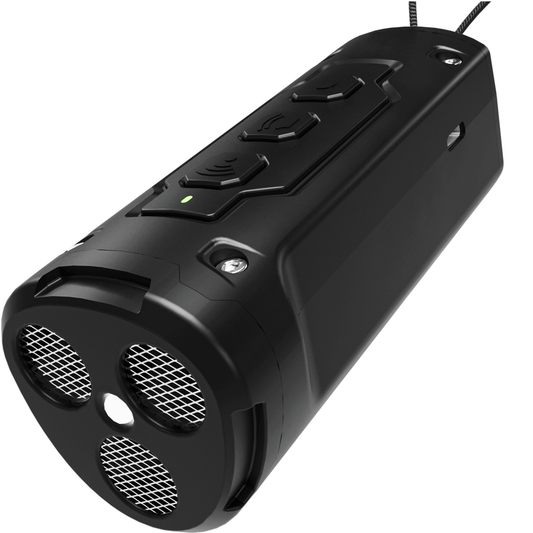how to stop your dog from barking, dog barking deterent stop dog barking device
If you're looking for a way to deter your dog from barking excessively, noise-emitting devices may be worth considering. These devices are designed to emit a high-pitched sound that is unpleasant for dogs to hear, which can help to discourage them from barking.
Noise-emitting devices work by emitting a loud, high-pitched sound that is only audible to dogs. When a dog barks, the device detects the sound and emits the unpleasant noise, which can startle the dog and encourage them to stop barking.
There are several different types of noise-emitting devices available, including ultrasonic bark deterrents, handheld devices, and stationary devices. Ultrasonic bark deterrents are small, handheld devices that emit a high-pitched sound when activated. They can be effective at stopping barking behavior in the moment, but they may not be effective in the long term.
Handheld devices are similar to ultrasonic bark deterrents but are usually larger and have a longer range. They are designed to be used outdoors and can be effective at deterring barking in your yard or neighborhood.
Stationary devices are designed to be placed in your yard or home and emit a high-pitched sound when activated. They are usually triggered by a dog barking, and can be effective at deterring barking behavior over time.
While noise-emitting devices can be effective at stopping barking behavior, it's important to use them appropriately and with caution. Some dogs may become desensitized to the noise over time, and using the devices too frequently or inappropriately can cause stress and anxiety in your dog.
In summary, noise-emitting devices can be an effective way to deter your dog from barking excessively. There are several different types of devices available, each with its own benefits and drawbacks. If you decide to use a noise-emitting device, be sure to use it appropriately and with caution to ensure the safety and well-being of your dog.
Citronella collars are a type of dog collar designed to deter excessive barking. These collars work by emitting a spray of citronella oil when the dog barks, which is intended to startle and discourage the dog from continuing to bark.
Citronella collars are typically worn around the neck, like a regular dog collar. When the dog barks, the collar is activated, and a spray of citronella oil is released. Citronella is a natural essential oil derived from citronella grass and is commonly used in insect repellents and other products.
The citronella spray is not harmful to the dog, but it is unpleasant and can be startling. The goal is to associate the unpleasant sensation with the barking behavior, and over time, the dog may learn to stop barking excessively to avoid the unpleasant sensation.
While citronella collars can be effective at deterring excessive barking, their effectiveness may vary depending on the dog. Some dogs may become desensitized to the citronella spray over time, while others may not be affected by it at all. It's important to use the collar appropriately and with caution to avoid causing unnecessary stress or anxiety in your dog.
One potential benefit of citronella collars is that they are a humane alternative to shock collars, which use an electric shock to deter barking behavior. Citronella collars do not cause pain or harm to the dog and are a more gentle way to address excessive barking behavior.
In conclusion, citronella collars are a type of dog collar designed to deter excessive barking by emitting a spray of citronella
- Understanding why dogs bark: the different reasons behind excessive barking, and how to address each cause.
Dogs communicate through barking, but excessive barking can become a problem for pet owners. Understanding why dogs bark is important in addressing and correcting excessive barking behavior.
One common reason dogs bark excessively is due to boredom or lack of exercise. Dogs that do not receive enough physical or mental stimulation can become restless and resort to excessive barking as a way to release energy. Providing regular exercise and interactive toys can help reduce boredom and alleviate excessive barking.
Fear and anxiety are other reasons for excessive barking in dogs. Dogs may bark excessively when they feel threatened or uncomfortable, such as during thunderstorms or when encountering new people or situations. Addressing the underlying fear or anxiety with desensitization techniques or calming aids can help reduce excessive barking.
Some dogs may bark excessively due to separation anxiety. These dogs may become stressed or anxious when left alone, and barking may be their way of coping with this anxiety. Addressing separation anxiety through gradual desensitization and training can help reduce barking and improve the dog's overall well-being.
Excessive barking can also be a territorial response in dogs, especially when they perceive a threat to their home or family. Addressing this type of barking may involve training and socialization to help the dog feel more secure and confident in their environment.
How to train a dog not to bark - How to choose the right deterrent: factors to consider when selecting a deterrent, such as your dog's breed and personality.
Choosing the right deterrent to stop your dog from excessive barking can be a difficult task, as there are many different types of deterrents available on the market. Factors to consider when selecting a deterrent include your dog's breed, personality, and the type of barking behavior they exhibit.
Firstly, it is important to consider your dog's breed when selecting a deterrent. Some breeds are naturally more vocal than others and may require a different approach in addressing their barking behavior. For example, a small breed like a Chihuahua may respond better to a citronella spray collar, while a larger breed like a German Shepherd may require a more intense stimulus, such as a high-frequency sound device.
Secondly, the personality of your dog should also be taken into account when selecting a deterrent. Some dogs may be more sensitive to certain types of stimuli, and a more gentle approach may be needed to correct their barking behavior. On the other hand, some dogs may require a stronger deterrent to stop their excessive barking.
Lastly, it is important to consider the type of barking behavior your dog exhibits. Different deterrents are designed to address different types of barking behavior, such as fear-induced barking or territorial barking. Choosing a deterrent that is tailored to your dog's specific barking behavior can increase its effectiveness in stopping the barking.
Seeking professional help: when and how to seek the advice of a professional dog trainer or behaviorist if your dog's barking behavior persists.
If your dog's barking behavior persists despite your efforts, seeking the advice of a professional dog trainer or behaviorist can be beneficial. These professionals are trained to assess your dog's behavior and provide tailored recommendations to address their excessive barking.
Knowing when to seek professional help is important. If your dog's barking behavior is causing disruption to your daily life or if they are exhibiting aggressive behavior, it may be time to consult a professional. Additionally, if your attempts to correct the barking behavior have been unsuccessful, it may indicate that your dog requires specialized attention.
When seeking professional help, it is important to do your research and choose a reputable trainer or behaviorist. Look for professionals with certifications or experience in addressing excessive barking behavior. They should be able to provide a comprehensive assessment of your dog's behavior and offer a personalized training plan to address the issue.
During the consultation, be prepared to provide details about your dog's behavior and any attempts you have made to correct it. The trainer or behaviorist may observe your dog's behavior in different settings and provide feedback on how to modify their behavior. They may also provide training exercises and techniques for you to practice with your dog at home.
Real-life success stories of using anti-barking devices on neighbor's dogs
If you're a pet owner, you know how frustrating it can be to have a neighbor's dog constantly barking, interrupting your peace and quiet. While it's important to address the root cause of the barking behavior, sometimes the use of an anti-barking device can provide immediate relief. Here are some real-life success stories of using anti-barking devices on neighbor's dogs.
One pet owner had a neighbor with a large dog who would bark incessantly, especially at night. The pet owner tried talking to the neighbor, but to no avail. After doing some research, they decided to try an ultrasonic anti-barking device. The first time they used it, they were surprised to see the neighbor's dog immediately stop barking and run inside. The pet owner continued to use the device when necessary, and the neighbor's dog eventually stopped barking altogether.
Another pet owner had a neighbor with two small dogs who would constantly bark when left alone in the yard. The pet owner tried talking to the neighbor and suggesting solutions, but nothing worked. They eventually decided to try a spray anti-barking device. The first few times they used it, the neighbor's dogs stopped barking for a few minutes, but then resumed. However, after consistent use over a few weeks, the neighbor's dogs stopped barking altogether and the yard became a peaceful place again.
Lastly, a pet owner had a neighbor with a dog who would bark at anything that moved, including people walking by on the sidewalk. The pet owner tried talking to the neighbor and even offered to help with training, but the neighbor declined. The pet owner decided to try a vibration anti-barking device that attaches to the neighbor's fence. After a few days of consistent use, the neighbor's dog stopped barking at people walking by and the pet owner was finally able to enjoy a peaceful walk in their neighborhood.
In conclusion, while it's important to address the root cause of barking behavior in dogs, anti-barking devices can be a helpful tool in providing immediate relief. These real-life success stories show that with consistent and responsible use, anti-barking devices can be effective in reducing or stopping a neighbor's dog from barking excessively.




